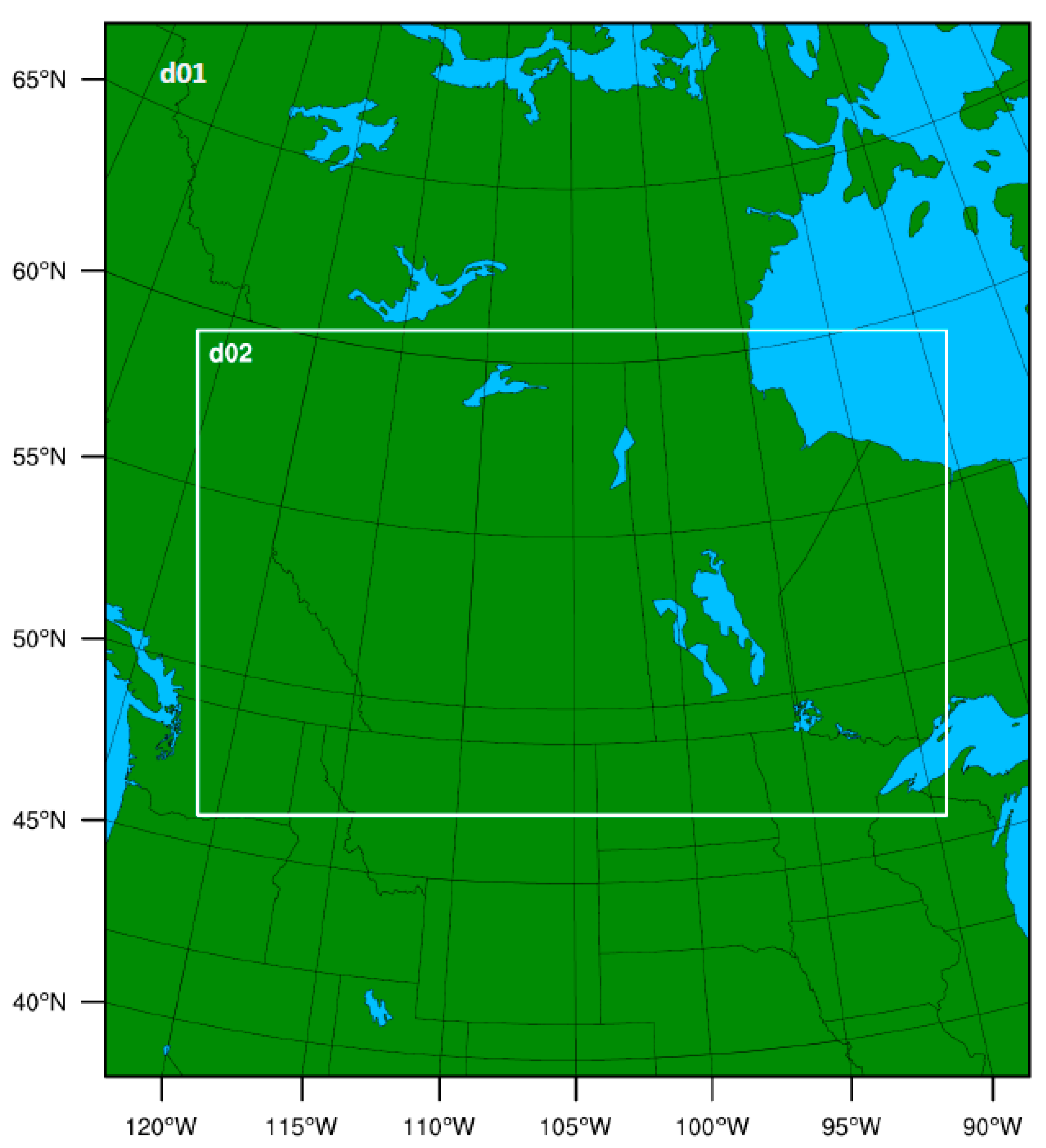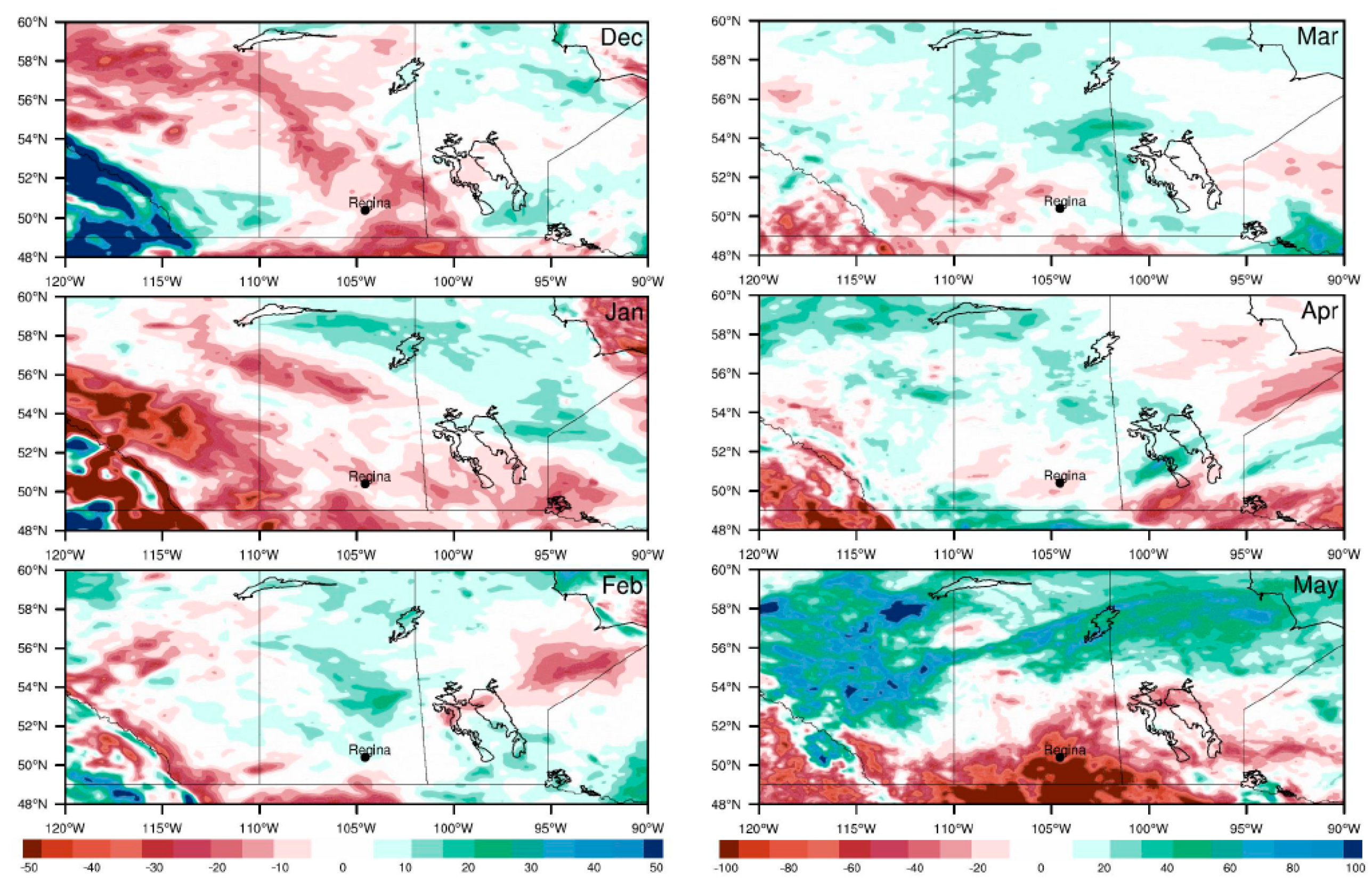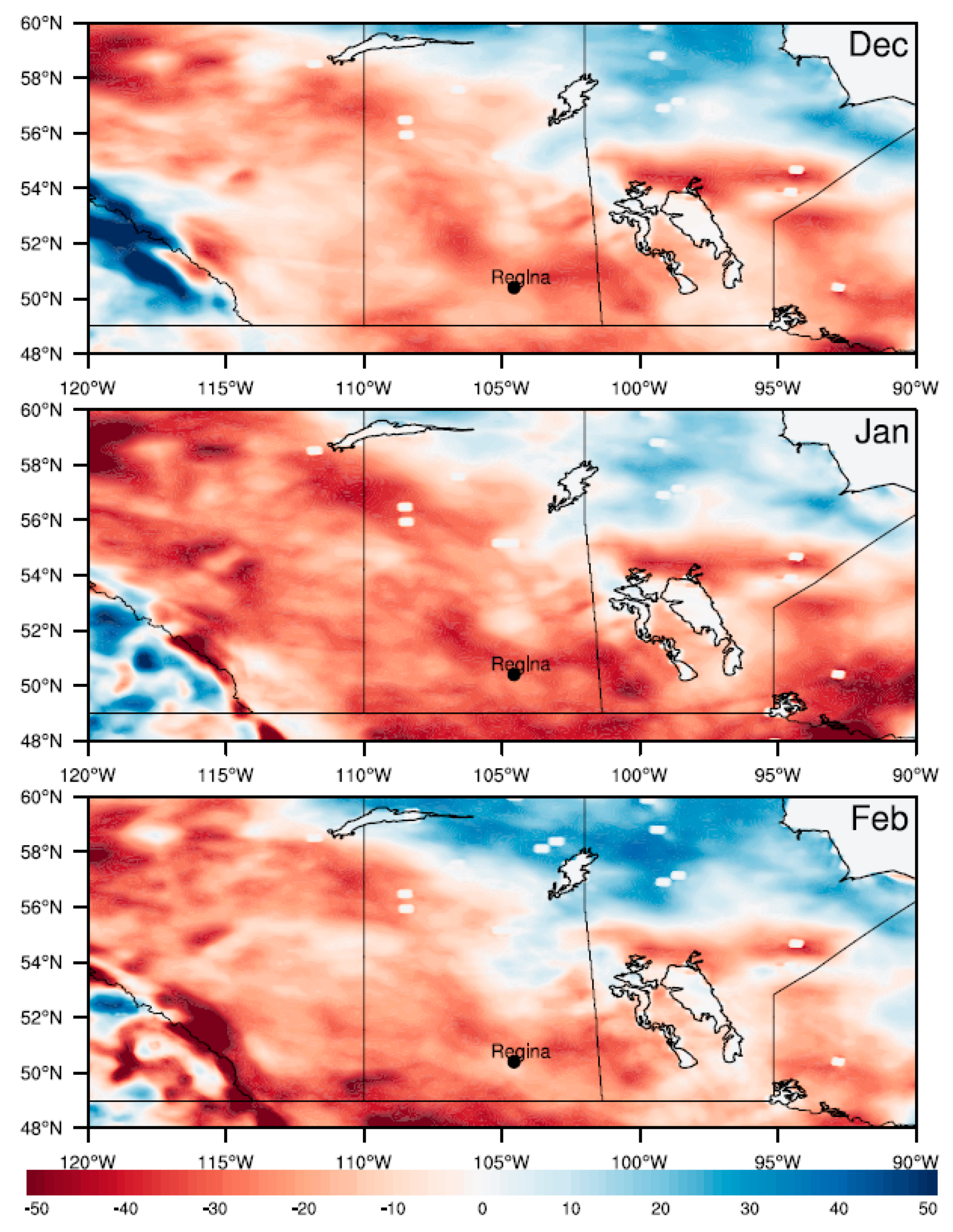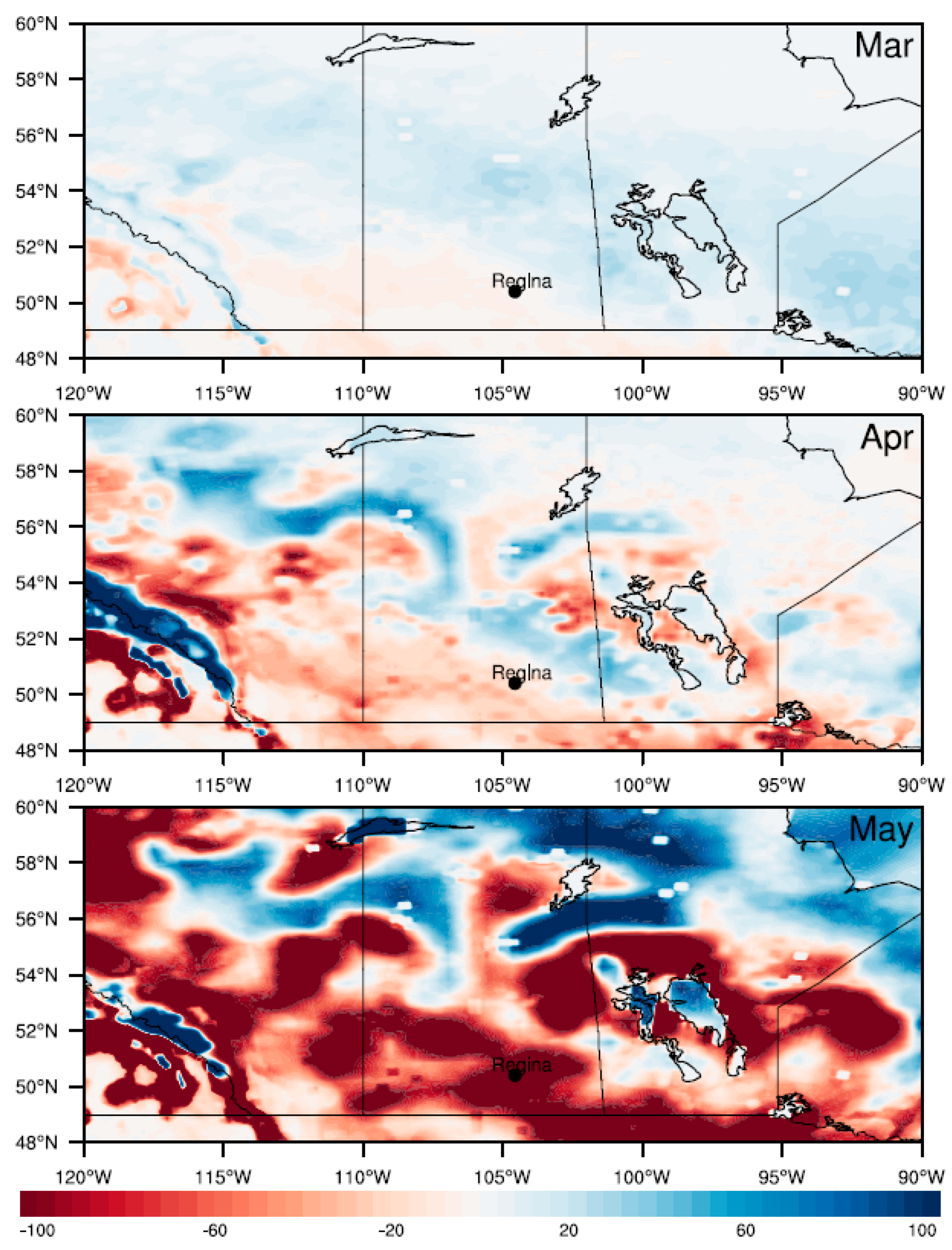Hydrological Extremes in the Canadian Prairies in the Last Decade due to the ENSO Teleconnection—A Comparative Case Study Using WRF
Abstract
:1. Introduction
2. Methodology and Modeling Experiment
3. Results
4. Conclusions
- (1)
- A lesser amount of precipitation in winter and spring during the El Niño of 2015–2016 in comparison to the 2010–2011 La Niña.
- (2)
- A decrease in soil moisture and surface runoff during the El Niño event of 2015–2016, especially in the southern Prairies.
- (3)
- The model simulation of precipitation, snow depth, and runoff during the El Niño of 2015–2016 and La Nina of 2010–2011 corresponds with observational data from weather stations and water gauges.
Author Contributions
Funding
Acknowledgments
Conflicts of Interest
References
- Sauchyn, D.; Vanstone, J.; Perez-Valdivia, C. Modes and Forcing of Hydroclimatic Variability in the Upper North Saskatchewan River Basin Since 1063. Can. Water Resour. J./Rev. Can. Ressour. Hydr. 2011, 36, 205–217. [Google Scholar] [CrossRef]
- Jacques, J.-M.S.; Huang, Y.A.; Zhao, Y.; Lapp, S.L.; Sauchyn, D.J. Detection and attribution of variability and trends in streamflow records from the Canadian Prairie Provinces. Can. Water Resour. J./Rev. Can. Ressour. Hydr. 2014, 39, 270–284. [Google Scholar] [CrossRef]
- Barrow, E.M.; Sauchyn, D.J. Uncertainty in climate projections and time of emergence of climate signals in the western Canadian Prairies. Int. J. Clim. 2019, 39, 4358–4371. [Google Scholar] [CrossRef]
- Stewart, R.E.; Szeto, K.K.; Bonsal, B.R.; Hanesiak, J.M.; Kochtubajda, B.; Li, Y.; Thériault, J.M.; Debeer, C.M.; Tam, B.Y.; Li, Z.; et al. Summary and synthesis of Changing Cold Regions Network (CCRN) research in the interior of western Canada—Part 1: Projected climate and meteorology. Hydrol. Earth Syst. Sci. 2019, 23, 3437–3455. [Google Scholar] [CrossRef] [Green Version]
- Bonsal, B.R.; Zhang, X.; Vincent, L.A.; Hogg, W.D. Characteristics of Daily and Extreme Temperatures over Canada. J. Clim. 2001, 14, 1959–1976. [Google Scholar] [CrossRef]
- Bonsal, B.; Shabbar, A. Impacts of Large-Scale Circulation Variability on Low Streamflows over Canada: A Review. Can. Water Resour. J./Rev. Can. Ressour. Hydr. 2008, 33, 137–154. [Google Scholar] [CrossRef] [Green Version]
- Szeto, K.; Zhang, X.; White, R.E.; Brimelow, J. The 2015 Extreme Drought in Western Canada. Bull. Am. Meteorol. Soc. 2016, 97, S42–S46. [Google Scholar] [CrossRef]
- Li, Z.; Li, Y.; Bonsal, B.; Manson, A.H.; Scaff, L. Combined impacts of ENSO and MJO on the 2015 growing season drought on the Canadian Prairies. Hydrol. Earth Syst. Sci. 2018, 22, 5057–5067. [Google Scholar] [CrossRef] [Green Version]
- Trenberth, K.E.; Hurrell, J.W. Decadal atmosphere-ocean variations in the Pacific. Clim. Dyn. 1994, 9, 303–319. [Google Scholar] [CrossRef]
- Hoerling, M.P.; Ting, M. Organization of Extratropical Transients during El Niño. J. Clim. 1994, 7, 745–766. [Google Scholar] [CrossRef] [Green Version]
- Eichler, T.; Higgins, W. Climatology and ENSO-Related Variability of North American Extratropical Cyclone Activity. J. Clim. 2006, 19, 2076–2093. [Google Scholar] [CrossRef]
- Compo, G.; Sardeshmukh, P.D. Removing ENSO-Related Variations from the Climate Record. J. Clim. 2010, 23, 1957–1978. [Google Scholar] [CrossRef]
- Bonsal, B.; Cuell, C.; Wheaton, E.; Sauchyn, D.J.; Barrow, E. An assessment of historical and projected future hydro-climatic variability and extremes over southern watersheds in the Canadian Prairies. Int. J. Clim. 2017, 37, 3934–3948. [Google Scholar] [CrossRef]
- Corkal, D.; Diaz, H.; Sauchyn, D. Changing Roles in Canadian Water Management: A Case Study of Agriculture and Water in Canada’s South Saskatchewan River Basin. Int. J. Water Res. Dev. 2011, 27, 647–664. [Google Scholar]
- Zhang, X.; Walsh, J.E.; Zhang, J.; Bhatt, U.S.; Ikeda, M. Climatology and Interannual Variability of Arctic Cyclone Activity: 1948–2002. J. Clim. 2004, 17, 2300–2317. [Google Scholar] [CrossRef]
- Yin, J.H. A consistent poleward shift of the storm tracks in simulations of 21st century climate. Geophys. Res. Lett. 2005, 32. [Google Scholar] [CrossRef] [Green Version]
- Ulbrich, U.; Leckebusch, G.C.; Pinto, J.G. Extra-tropical cyclones in the present and future climate: A review. Theor. Appl. Clim. 2009, 96, 117–131. [Google Scholar] [CrossRef] [Green Version]
- Basu, S.; Zhang, X.; Polyakov, I.; Bhatt, U.S. North American winter-spring storms: Modeling investigation on tropical Pacific sea surface temperature impacts. Geophys. Res. Lett. 2013, 40, 5228–5233. [Google Scholar] [CrossRef]
- Environment and Climate Change Canada. Standardized Precipitation Evapotranspiration Index Data. 2019. Available online: http://climate-scenarios.canada.ca/?page=spei (accessed on 23 September 2019).
- Bush, E.; Lemmen, D.S. (Eds.) Canada’s Changing Climate Report; Government of Canada: Ottawa, ON, Canada, 2019; 444p.
- Hogg, E.H. Temporal scaling of moisture and the forest-grassland boundary in western Canada. Agric. For. Meteorol. 1997, 84, 115–122. [Google Scholar] [CrossRef] [Green Version]
- Stewart, R.E.; Pomeroy, J.; Lawford, R. The Drought Research Initiative: A Comprehensive Examination of Drought over the Canadian Prairies. Atmosphere-Ocean 2011, 49, 298–302. [Google Scholar] [CrossRef]
- Hanesiak, J.; Stewart, R.E.; Bonsal, B.R.; Harder, P.; Lawford, R.; Aider, R.; Amiro, B.D.; Atallah, E.; Barr, A.G.; Black, T.A.; et al. Characterization and Summary of the 1999–2005 Canadian Prairie Drought. Atmosphere-Ocean 2011, 49, 421–452. [Google Scholar] [CrossRef]
- Pomeroy, J.; Stewart, R.E.; Whitfield, P.H. The 2013 flood event in the South Saskatchewan and Elk River basins: Causes, assessment and damages. Can. Water Resour. J./Rev. Can. Ressour. Hydr. 2015, 41, 105–117. [Google Scholar] [CrossRef]
- Shabbar, A.; Yu, B. Intraseasonal Canadian Winter Temperature Responses to Interannual and Interdecadal Pacific SST Modulations. Atmosphere-Ocean 2012, 50, 109–121. [Google Scholar] [CrossRef]
- Shabbar, A.; Khandekar, M. The impact of el Nino-Southern oscillation on the temperature field over Canada: Research note. Atmosphere-Ocean 1996, 34, 401–416. [Google Scholar] [CrossRef]
- Shabbar, A.; Bonsal, B.; Khandekar, M. Canadian Precipitation Patterns Associated with the Southern Oscillation. J. Clim. 1997, 10, 3016–3027. [Google Scholar] [CrossRef]
- Skamarock, W.C.; Klemp, J.B.; Dudhia, J.; Gill, D.O.; Liu, Z.; Berner, J.; Wang, W.; Powers, J.G.; Duda, M.G.; Barker, D.M.; et al. A Description of the Advanced Research WRF Version 4; No. NCAR/TN-556+STR; NCAR Tech: Boulder, CO, USA, 2019; 145p. [Google Scholar] [CrossRef]
- Hong, S.-Y.; Lim, J.-O.J. The WRF single–moment 6–class microphysics scheme (WSM6). J. Korean Meteorol. Soc. 2006, 42, 129–151. [Google Scholar]
- Kain, J.S. The Kain–Fritsch convective parameterization: An update. J. App. Met. 2004, 43, 170–181. [Google Scholar] [CrossRef] [Green Version]
- Collins, W.D.; Rasch, P.J.; Boville, B.A.; Hack, J.J.; McCaa, J.R.; Williamson, D.L.; Briegleb, B.P.; Bitz, C.M.; Lin, S.-J.; Zhang, M. The Formulation and Atmospheric Simulation of the Community Atmosphere Model Version 3 (CAM3). J. Clim. 2006, 19, 2144–2161. [Google Scholar] [CrossRef] [Green Version]
- Nakanishi, M.; Niino, H. Development of an Improved Turbulence Closure Model for the Atmospheric Boundary Layer. J. Meteorol. Soc. Jpn. 2009, 87, 895–912. [Google Scholar] [CrossRef] [Green Version]
- Olson, J.B.; Kenyon, J.S.; Angevine, W.M.; Brown, J.M.; Pagowski, M.; Sušelj, K. A Description of the MYNN-EDMF Scheme and the Coupling to Other Components in WRF–ARW; NOAA Technical Memorandum OAR GSD; NOAA: Washington, DC, USA, 2019; Volume 61, p. 37. [CrossRef]
- Jiménez, P.A.; Dudhia, J.; González-Rouco, J.F.; Navarro, J.; Montávez, J.P.; García-Bustamante, E. A Revised Scheme for the WRF Surface Layer Formulation. Mon. Weather Rev. 2012, 140, 898–918. [Google Scholar] [CrossRef] [Green Version]
- Tewari, M.; Chen, F.; Wang, W.; Dudhia, J.; LeMone, M.A.; Mitchell, K.; Ek, M.; Gayno, G.; Wegiel, J.; Cuenca, R.H. Implementation and verification of the unified NOAH land surface model in the WRF model. In Proceedings of the 20th Conference on Weather Analysis and Forecasting/16th Conference on Numerical Weather Prediction, Seattle, WA, USA, 12 January 2004; pp. 11–15. [Google Scholar]
- Hutchinson, M.F.; McKenney, D.W.; Lawrence, K.; Pedlar, J.H.; Hopkinson, R.F.; Milewska, E.; Papadopol, P. Development and Testing of Canada-Wide Interpolated Spatial Models of Daily Minimum–Maximum Temperature and Precipitation for 1961–2003. J. Appl. Meteorol. Clim. 2009, 48, 725–741. [Google Scholar] [CrossRef]
- Hopkinson, R.F.; McKenney, D.W.; Milewska, E.; Hutchinson, M.F.; Papadopol, P.; Vincent, L.A. Impact of Aligning Climatological Day on Gridding Daily Maximum–Minimum Temperature and Precipitation over Canada. J. Appl. Meteorol. Clim. 2011, 50, 1654–1665. [Google Scholar] [CrossRef]
- McKenney, D.W.; Hutchinson, M.F.; Papadopol, P.; Lawrence, K.; Pedlar, J.; Campbell, K.; Milewska, E.; Hopkinson, R.F.; Price, D.; Owen, T. Customized Spatial Climate Models for North America. Bull. Am. Meteorol. Soc. 2011, 92, 1611–1622. [Google Scholar] [CrossRef]
- Vincent, L.A.; Wang, X.L.; Milewska, E.J.; Wan, H.; Yang, F.; Swail, V. A second generation of homogenized Canadian monthly surface air temperature for climate trend analysis. J. Geophys. Res. Space Phys. 2012, 117. [Google Scholar] [CrossRef]
- Asong, Z.E.; Wheater, H.S.; Bonsal, B.; Razavi, S.; Kurkute, S. Historical drought patterns over Canada and their teleconnections with large-scale climate signals. Hydrol. Earth Syst. Sci. 2018, 22, 3105–3124. [Google Scholar] [CrossRef] [Green Version]
- Perez-Valdivia, C.; Sauchyn, D.; Vanstone, J. Groundwater levels and teleconnection patterns in the Canadian Prairies. Water Resour. Res. 2012, 48. [Google Scholar] [CrossRef]










| Regina | ||||
|---|---|---|---|---|
| Simulated La Nina | Simulated El Nino | Simulated Difference | Observed Difference | |
| December | 24 | 19 | −5 | −1 |
| January | 42 | 26 | −16 | −12 |
| February | 21 | 27 | 6 | 2 |
| March | 48 | 53 | 5 | 2 |
| April | 52 | 41 | −11 | −16 |
| May | 121 | 62 | −59 | −36 |
| STREAMFLOW GAUGE | Difference (m3/s; 2016–2011) | ||
|---|---|---|---|
| March | April | May | |
| NSR near Deer Creek, AB | 101 | −31 | −216 |
| NSR at Prince Albert, SK | 83 | −138 | −290 |
| SSR at Medicine Hat, AB | −28.9 | −207.7 | −484 |
| SSR at Saskatoon, SK | −121 | −168 | −676.8 |
| Drought Net Stations (AGDM) | Difference (m3 m−3; 2016–2011) | ||||
|---|---|---|---|---|---|
| SOIL MOISTURE | PRECIPITATION | ||||
| March | April | May | WINTER | SPRING | |
| Manning (North, AB) | −0.029 | 6.239 | −6.394 | −29.4 | 62.7 |
| Stettler (South Central, AB) | 9.191 | −7.555 | −3.16 | −11.24 | 59.1 |
| Neir (South West, AB) | 12.705 | −11.347 | −10.98 | −1.4 | −78.7 |
| Del Bonita (South, AB) | −0.547 | −9.48 | −5.397 | −18.9 | −12.4 |
| Mundare (Central, AB) | 8.005 | −4.121 | −0.006 | −14.3 | 123 |
Publisher’s Note: MDPI stays neutral with regard to jurisdictional claims in published maps and institutional affiliations. |
© 2020 by the authors. Licensee MDPI, Basel, Switzerland. This article is an open access article distributed under the terms and conditions of the Creative Commons Attribution (CC BY) license (http://creativecommons.org/licenses/by/4.0/).
Share and Cite
Basu, S.; Sauchyn, D.J.; Anis, M.R. Hydrological Extremes in the Canadian Prairies in the Last Decade due to the ENSO Teleconnection—A Comparative Case Study Using WRF. Water 2020, 12, 2970. https://doi.org/10.3390/w12112970
Basu S, Sauchyn DJ, Anis MR. Hydrological Extremes in the Canadian Prairies in the Last Decade due to the ENSO Teleconnection—A Comparative Case Study Using WRF. Water. 2020; 12(11):2970. https://doi.org/10.3390/w12112970
Chicago/Turabian StyleBasu, Soumik, David J. Sauchyn, and Muhammad Rehan Anis. 2020. "Hydrological Extremes in the Canadian Prairies in the Last Decade due to the ENSO Teleconnection—A Comparative Case Study Using WRF" Water 12, no. 11: 2970. https://doi.org/10.3390/w12112970
APA StyleBasu, S., Sauchyn, D. J., & Anis, M. R. (2020). Hydrological Extremes in the Canadian Prairies in the Last Decade due to the ENSO Teleconnection—A Comparative Case Study Using WRF. Water, 12(11), 2970. https://doi.org/10.3390/w12112970





